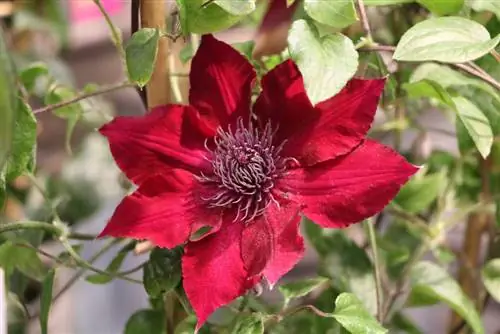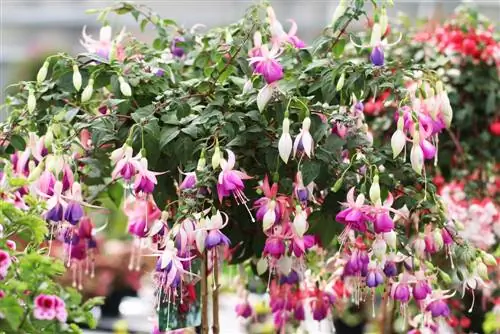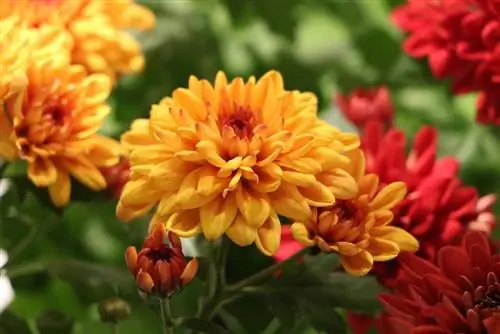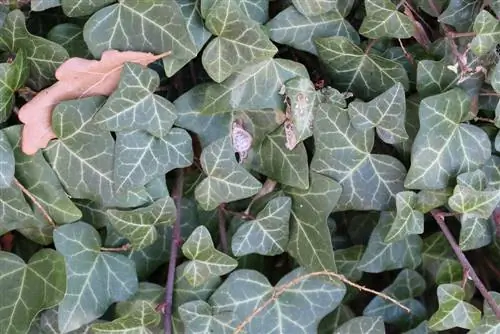- Author admin [email protected].
- Public 2023-12-17 03:39.
- Last modified 2025-06-01 06:48.
The more than 300 clematis species found worldwide include deciduous and evergreen climbing shrubs as well as lavishly flowering, herbaceous perennials. Given this diversity, it is obvious that the question of winter hardiness cannot be answered with a simple yes or no. A differentiated approach sheds light on the darkness and ensures that your clematis is not left with a brief interlude in the garden and on the balcony. The following instructions describe in a compact and understandable manner how to overwinter a clematis in a species-appropriate manner.
They are all perennial - not always hardy
Clematis are among the cosmopolitans in the plant kingdom. They can be found in the wild in almost every region of the world, although they prefer forested mountains, which is where their middle name, clematis, comes from. They predominantly thrive as deciduous climbing plants that use their bendable leaf stems to climb up trees. A few clematis have chosen tropical and subtropical climates as their home, where they keep their foliage all year round thanks to the mild temperatures.
In their respective areas of distribution, clematis have the potential for a long life. Under ideal conditions, the climbing artists reach an age between 20 and 70 years. The European and Asian species succeed in this because they have good winter hardiness. In contrast, evergreen clematis do not experience frost, so they are not hardy - regardless of their perennial growth. The following overview of the most popular species for the ornamental garden provides information about the differentiated winter hardiness:
- True/common clematis (Clematis vitalba): hardy down to -37 degrees Celsius
- Italian clematis (Clematis viticella): hardy down to -25 degrees Celsius
- Alpine clematis (Clematis alpina): hardy down to -25 degrees Celsius
- Perennial clematis (Clematis integrifolia, Clematis recta): hardy down to -25 degrees Celsius
- Mountain clematis (Clematis montana): hardy down to -20 degrees Celsius
- Japanese clematis (Clematis florida): hardy down to -12 degrees Celsius
- Chinese, semi-evergreen clematis (Clematis kweichowensi): hardy down to -12 degrees Celsius
- Chinese evergreen clematis (Clematis armandii): hardy down to -6 degrees Celsius
- Australian evergreen clematis (Clematis microphylla): not hardy: minimum temperature 5 degrees Celsius
While concrete statements can be made about the winter hardiness of pure species, this does not apply to the opulent hybrids. After all, based on the parent plants, conclusions can be drawn about the extent to which a hybrid is cold-resistant. The world-famous clematis 'Rubens' comes from Clematis montana and has a similarly good winter hardiness. The Italian clematis was the inspiration for numerous Jackmanii hybrids, which stand out with particularly large flowers and are just as frost-tolerant as the pure variety.
Overwintering frost-sensitive clematis - this is how it works
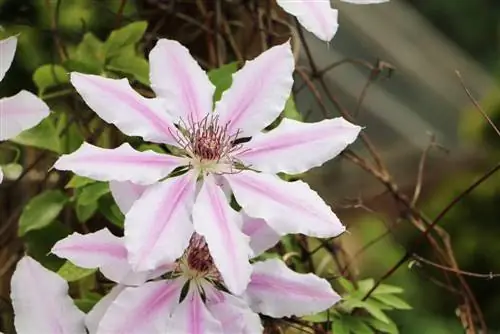
The overwintering of evergreen, semi-evergreen and other partially winter-hardy clematis is rarely successful outdoors, so cultivation in a bucket is recommended. The corresponding species and all hybrids resulting from them will only provide you with multi-year growth if they can spend the cold season behind glass. This is how wintering works:
- Clear when the nighttime temperature minimum is 5 degrees Celsius
- The winter quarters are bright and frost-free at 5 to 15 degrees Celsius
- Do not fertilize from September to March
- Reduce watering so that the root ball does not dry out
Is your garden located in a mild-winter wine-growing region or does it have an adequate microclimate? Then there is a good chance that the early-flowering, evergreen Clematis armandii can be planted out. However, you should not forego winter protection. Covering the root disc with leaves and brushwood keeps frost and snow at bay. In the first 2 to 3 years of growth, a reed mat protects the shoots from icy winds.
Hardy species are vulnerable in pots
Information on winter hardiness refers exclusively to clematis in the bed. Deep in the ground, the root ball is so well protected that it can survive severe frost. Local site conditions and professional planting play a role in this approach. This does not apply to potted plants, as the root ball is in a vulnerable position. The comparatively small substrate volume and the thin vessel walls do not provide sufficient protection against frost. With the following precautions, frost-resistant clematis species in pots can still overwinter outside:
- Before the onset of winter, cover the pot with several layers of foil
- To protect against frost from below, place the bucket on a block of wood
- Cover the substrate with autumn leaves, wood shavings or bark mulch
In wind-exposed locations, surround the pot with a coconut or reed mat that extends over the edge of the pot by around 10 cm. A location in front of the south wall of the house or in a garden niche protected from rain and wind is advantageous.
Tip:
A low-competition underplanting ensures a shady base in summer and serves as a buffer zone against frost in winter. Small ornamental grasses and ferns fulfill this task perfectly as useful foot soldiers for the royal clematis. The Japanese mountain grass (Hakonechloa macra), the delicate forest grove (Luzula sylvatica) or the small Himalayan venus hair fern (Adiantum venustum) are excellent candidates for this function.
Protect frost-resistant climbing shrubs during the planting year
If your clematis is neither a cold-sensitive nor a potted plant, you still cannot avoid winter protection. At least in the year of planting, the climbing queen cannot do without these supportive measures against severe frost:
- In late autumn, pile up the bed soil with leaves and conifers
- Place brushwood around the young shoots as a windbreak
- Stop giving fertilizer from September
- Water every now and then when there is frost in winter so that the rhizome does not dry out
If a hardy clematis species has survived its first winter he althy with this protection, it will have stable frost resistance on its own in the following years. If the plant suffers severe frost periods and freezes back, this is no cause for alarm. In spring, cut the dead shoots back to he althy wood. The clematis sprouts again from a vital rootstock.
Tip:
Proper planting contributes significantly to the successful overwintering of a garden clematis. Choose a sunny to semi-shady location to plant the young clematis so deeply that the root collar is covered with soil by around 10 cm.
Perennial clematis take on special status
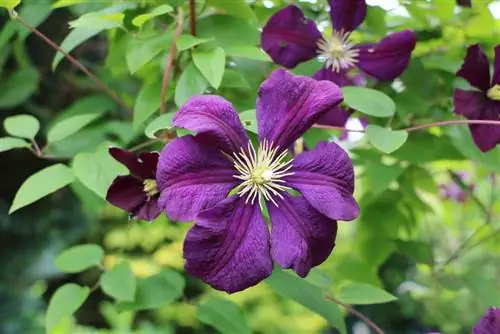
Perennial clematis are the survivors within the multi-faceted clematis genus. The herbaceous plants thrive in almost any location and delight with their beautiful flower and leaf shapes. Since they have no climbing organs, the shoots are directed in the desired direction using climbing aids. Some species, however, develop such strong stems that they do not require any support. All perennial clematis are reliably frost-stable. The herbaceous shoots die down completely in winter, only to sprout again in the spring. In order to properly overwinter herbaceous clematis species, vigorous pruning is integrated into the care program. How to do it professionally:
- In November or December cut back all shoots to 10 or 20 cm above the ground
- In the year of planting, cover the root disk with a layer of leaves and pine fronds
- Equip the bucket every year with a winter coat made of foil, jute or fleece
If the mercury column exceeds freezing point in early spring, the winter protection can be removed. In order to protect the young shoots and buds from late ground frosts, a light and breathable fleece should be ready to hand by the end of May. If the weather forecast predicts frost at night, a simple hood can protect a perennial clematis from frostbite.
These varieties are extra hardy
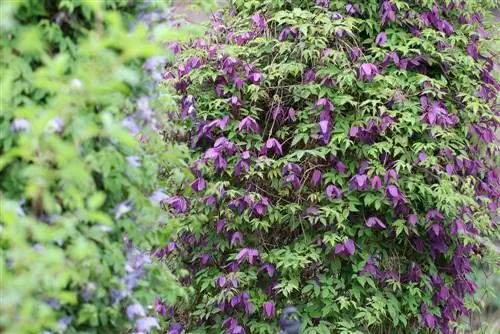
Do you consult this overwintering guide before purchasing a clematis? Then shortlist one of the following hand-picked species and varieties that have proven to be particularly frost-resistant in practice:
Blue Princess (Clematis alpina)
The early-flowering alpine clematis is native to Germany, so it has a stable frost hardiness down to -25 degrees Celsius. The royal flower beauty also scores points with its twice-flowering period, impressive vigor and he althy constitution. Its light blue flowers with a white center grow to a size of 5 cm and appear in such large numbers that they almost cover the light green leaves.
- Flowering period: April to May and September
- Growth height: 220 to 320 cm
The President (Clematis hybrid)
You can't ignore these premium varieties. Where The President resides, facades and fences are transformed into a furious sea of flowers. Each individual flower shines in purple red and boasts a diameter of at least 10 cm. The numerous advantages of this proven clematis hybrid include unconditional winter hardiness down to -25 degrees Celsius.
- Flowering period: May to September
- Growth height: 180 to 400 cm
Blue Angel (Clematis viticella)
With its Italian temperament and light blue, ruffled flowers, this clematis has gained a large following among home gardeners. Their popularity is also based on robust he alth and fail-safe winter hardiness for up to -25 degrees Celsius.
- Flowering period: June to October
- Growth height: 200 to 400 cm
Odorata (Clematis montana)
A lavish abundance of flowers, impressive vigor and a winter hardiness down to -20 degrees Celsius characterize this high-quality mountain clematis. Where large facades need to be greened, the light pink flowering Odorata should be at the top of the wish list. The cross-shaped petals frame a sunny yellow center and exude a seductive vanilla scent.
- Flowering time: May and June
- Growth height: 400 to 1200 cm
Baby Blue - perennial clematis (Clematis integrifolia)
It impresses with blue bell flowers, two blooms and decorative fruit decorations in autumn. In winter, the perennial clematis retreats into its rootstock, which can easily endure bitter frost down to -25 degrees Celsius. When the first rays of sunshine warm the ground in spring, the young shoots eagerly sprout to repeat their flower festival.
- Flowering period: May to June and September
- Growth height: 30 to 40 cm
Conclusion
Clematis thrive around the globe as perennial climbing plants with a fairytale abundance of flowers. Although a clematis can live up to 70 years, this is not always accompanied by reliable frost resistance. At least tropical evergreen clematis have not learned to survive in winter conditions. Therefore, they should be cultivated in pots and overwintered behind glass. The vast majority of European and Asian clematis species are so hardy that light winter protection only makes sense in the year of planting and in the container. As these instructions for overwintering explain in detail, simple precautions are enough to provide safe guidance for the queen of climbing plants through the cold season.

